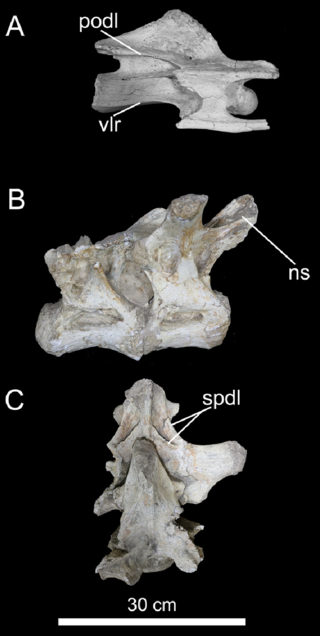
Trigonosaurus, is a genus of saltasaurid dinosaurs from the Maastrichtian Serra da Galga Formation of Brazil. The type species, Trigonosaurus pricei, was first described by Campos, Kellner, Bertini, and Santucci in 2005. It was based on two specimens, both consisting mainly of vertebrae. The two specimens were originally believed to have come from the same individual. However, one specimen was described as the holotype of Caieiria in 2022, while the holotype may have instead come from Baurutitan. Before its description, it was known as the "Peirópolis titanosaur", after the place it was found.

Maxakalisaurus is a genus of titanosaur dinosaur, found in the Adamantina Formation of Brazil, in the state of Minas Gerais in 1998. The genus name is derived from the tribe of the Maxakali; Topa is one of their divinities.
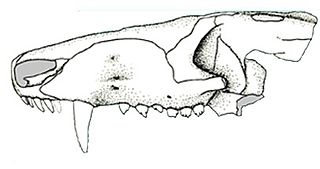
Prozostrodon is an extinct genus of probainognathian cynodonts that was closely related to mammals. The remains were found in Brazil and are dated to the Carnian age of the Late Triassic. The holotype has an estimated skull length of 6.7 centimetres (2.6 in), indicating that the whole animal may have been the size of a cat. The teeth were typical of advanced cynodonts, and the animal was probably a carnivore hunting reptiles and other small prey.
Hylaeamys megacephalus, also known as Azara's broad-headed oryzomys or the large-headed rice rat, is a species of rodent in the genus Hylaeamys of family Cricetidae, of which it is the type species. It is found mainly in lowland tropical rainforest from its type locality in Paraguay north through central Brazil, French Guiana, Guyana, Suriname, and Venezuela onto Trinidad and Tobago. To its west and east, other closely related species of Hylaeamys are found: H. perenensis in western Amazonia, H. acritus in Bolivia, and H. laticeps and H. oniscus in the Atlantic Forest of eastern Brazil.

Montealtosuchus is an extinct genus of terrestrial crocodyliform. It was discovered in 2004 in the Bauru Basin of Brazil, from Campanian-Maastrichtian deposits of the Adamantina Formation. The species was described in 2007, and assigned to the family Peirosauridae. The type species is M. arrudacamposi. The genus takes its name from the type locality in Monte Alto municipality.

Sphagesaurus is an extinct genus of sphagesaurid notosuchian crocodylomorph from the Late Cretaceous of southwest São Paulo, southern Brazil.
Caririemys is an extinct genus of side-necked turtles, belonging to the Pelomedusoides of the family Euraxemydidae. The type species is C. violetae. A single fossil of an individual was found in the Santana Formation in Brazil, an 80-million-year-old Late Cretaceous deposit that has so far preserved other fossil reptiles such as dinosaurs and crocodilians.

Cearachelys is an extinct genus of pleurodiran turtle which existed some 110 million years ago. The genus is monotypic, with only type species Cearachelys placidoi known.
Aides is a Neotropical genus of skippers in the family Hesperiidae.
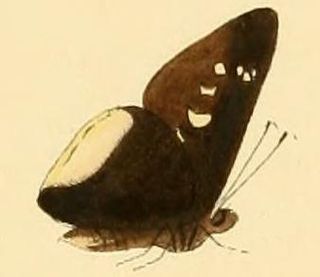
Eutychide is a genus of skippers in the family Hesperiidae.
Ludens is a genus of skippers in the family Hesperiidae.
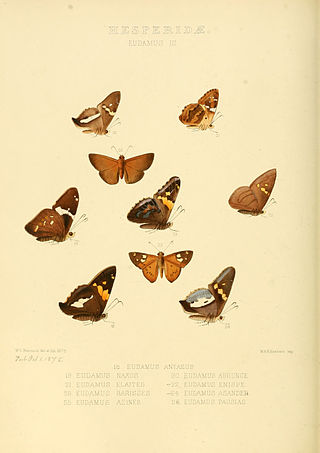
Aguna is a genus of Neotropical skipper butterflies in the family Hesperiidae (Eudaminae).
Charruodon is an extinct genus of cynodonts which existed in the Hyperodapedon Assemblage Zone of the Santa Maria Formation in the Paraná Basin in southeastern Brazil during the Late Triassic. The genus contains only the type species Charruodon tetracuspidatus, which is known from a single specimen of uncertain provenance. Upon its first description, Charruodon was tentatively placed within the family Therioherpetidae, but a 2017 study by Agustín G. Martinelli and colleagues instead recovered it as a more basal member of Probainognathia. In 2023, Hoffmann, Ribeiro & de Andrade reinterpreted the specimen as representing an early ontogenetic stage, and C. tetracuspidatus to be a nomen dubium.

Roxochampsa is an extinct genus of crocodylomorph from the Late Cretaceous of Brazil belonging to the sebecosuchian clade Itasuchidae. The type species is R. paulistanus.

Boreostemma is an extinct genus of glyptodonts from northern South America. Fossils assigned to the genus were first described as belonging to Asterostemma from southern South America, but have been placed in the new genus Boreostemma by Carlini et al. in 2008. The type species is B. pliocena. Fossils of Boreostemma have been found in the Honda Group of Colombia, in Peru and Venezuela.
Itapecuruemys is an extinct genus of bothremydid pleurodiran turtle that was discovered in the Itapecuru Formation of Brazil. It is a monotypic genus, with only type species Itapecuruemys amazoniensis known.

Lingyuanopterus is a genus of istiodactylid pterosaur from the Aptian age Jiufotang Formation in western Liaoning, China. The type and only species is L. camposi, known from the holotype specimen IVPP V 17940 a near complete skull, mandible and atlas-axis complex.
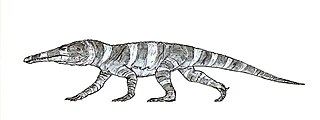
Stenoscelida is a genus of proterochampsid archosauriforms from the Late Triassic Santa Maria Supersequence of Rio Grande do Sul, Brazil. The genus contains a single species, S. aurantiacus, known from a right hind limb.

Caieiria is a genus of titanosaurian dinosaur from the Late Cretaceous Serra da Galga Formation of Brazil. The type and only species is Caieiria allocaudata.












